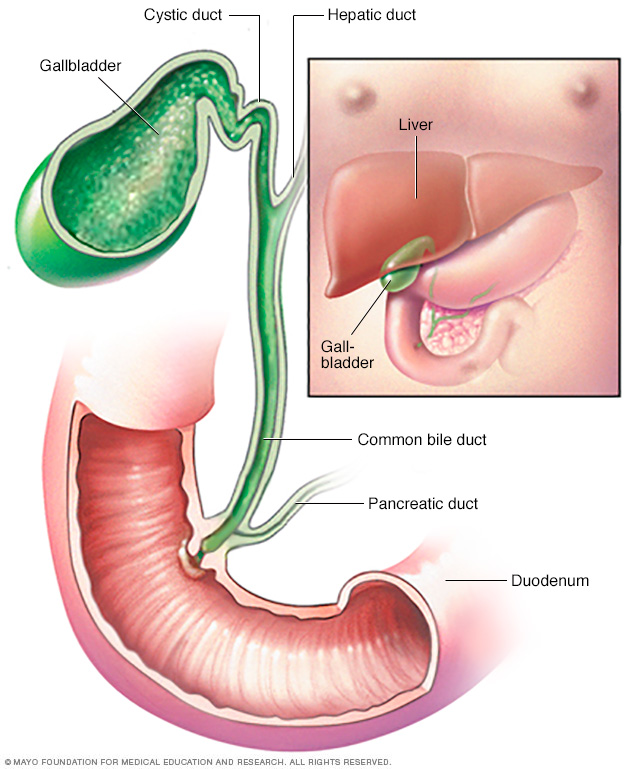Hilar cholangiocarcinoma
Overview
Hilar cholangiocarcinoma is a type of bile duct cancer that occurs in the bile ducts that lead out of the liver (hepatic ducts) and join with the gallbladder. Hilar cholangiocarcinomas are also known as Klatskin tumors.

The gallbladder stores bile, a yellow-green fluid produced in the liver. Bile flows from your liver into your gallbladder, where it's held until needed during the digestion of food. When you eat, your gallbladder releases bile into the bile duct, where it's carried to the upper part of the small intestine, called the duodenum, to help break down fat in food.
Diagnosis
Tests and procedures used to diagnose hilar cholangiocarcinoma include:
- Imaging tests, such as computerized tomography (CT) and magnetic resonance imaging (MRI)
- Blood test for very high levels of the CA 19-9 tumor marker
Biopsy using endoscopic retrograde cholangiopancreatography (ERCP) or endoscopic ultrasound and specialized lab testing with fluorescence in situ hybridization (FISH)
Doctors typically don't recommend collecting cells using a needle inserted through your skin and into your bile duct (transperitoneal biopsy). This technique increases the risk of cancer recurrence and may make you ineligible for a liver transplant.
Treatment
Which treatment is best for you will depend on the location and extent of your hilar cholangiocarcinoma. Treatment typically involves surgery, liver transplant or supportive treatments to reduce your pain and other symptoms.
Surgery
Surgery for hilar cholangiocarcinoma involves removing:
- The cancer
- Surrounding bile ducts
- Portions of the liver
- Nearby lymph nodes
The surgeon then connects the remaining bile ducts to the small intestine so that bile can still reach your digestive tract and help digest food.
Liver transplant
Some people with early-stage hilar cholangiocarcinoma may consider liver transplant. Chemotherapy and radiation are typically used before the liver transplant to kill as many cancer cells as possible before surgery.
This treatment typically involves:
- Intravenous chemotherapy with a medicine that makes your cells more vulnerable to radiation
- External beam radiation therapy
- Internal radiation (brachytherapy) using small wires that are placed near the cancer and slowly release radiation
- Chemotherapy in pill form until transplant surgery
- Minimally invasive surgery to look for signs that cancer has spread
- Liver transplant with a donor liver if one becomes available
You may undergo routine tests to evaluate your health while waiting for a liver transplant to make sure you're healthy enough for the surgery.
Chemotherapy
People with advanced hilar cholangiocarcinoma who aren't able to undergo surgery or liver transplant may receive chemotherapy to slow the growth of the cancer.
Last Updated Jun 6, 2023
© 2024 Mayo Foundation for Medical Education and Research (MFMER). All rights reserved. Terms of Use



